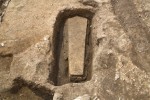 When the skeletal remains of King Richard III were found under a Leicester parking lot in two magical weeks September of 2012, the excavation team encountered another four graves in Trench 3 (Richard was found in Trench 1, see map here) on the site of what had once been the Grey Friars’ church. One of them stood out thanks to its limestone sarcophagus which was the first complete medieval stone coffin excavated in Leicester using modern archaeological methods. The other bodies had no surviving caskets, although evidence was found of two of them having been buried in long-decayed wooden coffins. Since the University of Leicester excavation team was under extreme time constraints, there was no question of exploring any other graves than the potential Richard’s at that time.
When the skeletal remains of King Richard III were found under a Leicester parking lot in two magical weeks September of 2012, the excavation team encountered another four graves in Trench 3 (Richard was found in Trench 1, see map here) on the site of what had once been the Grey Friars’ church. One of them stood out thanks to its limestone sarcophagus which was the first complete medieval stone coffin excavated in Leicester using modern archaeological methods. The other bodies had no surviving caskets, although evidence was found of two of them having been buried in long-decayed wooden coffins. Since the University of Leicester excavation team was under extreme time constraints, there was no question of exploring any other graves than the potential Richard’s at that time.
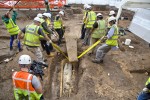 In July of 2013 the team returned to the Grey Friars site to excavate more of the church and, if possible, lift the stone sarcophagus found in the presbytery. The limestone box was cut in a tapered shape from a single block of limestone. The wider end was carved into a curve on the inside to create a niche for the head. The lid, also carved from limestone, didn’t quite fit and the mortar sealing it to the coffin was damaged. Water was able to get inside the coffin and over the centuries the unbalanced but very heavy lid fractured the sarcophagus extensively.
In July of 2013 the team returned to the Grey Friars site to excavate more of the church and, if possible, lift the stone sarcophagus found in the presbytery. The limestone box was cut in a tapered shape from a single block of limestone. The wider end was carved into a curve on the inside to create a niche for the head. The lid, also carved from limestone, didn’t quite fit and the mortar sealing it to the coffin was damaged. Water was able to get inside the coffin and over the centuries the unbalanced but very heavy lid fractured the sarcophagus extensively.
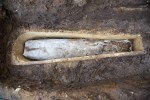 While they had hoped to lift the sarcophagus whole, archaeologists realized once they’d chiseled away the dirt caked on the sides of the coffin that the stone was too cracked to remain intact during the lifting process. They decided instead to lift the lid and remove it separately first. Nine people used lifting straps to manually raise the lid to ground level. Inside the sarcophagus they found a second coffin, this one made from lead. It was intact except for a hole at the feet where the lead had collapsed inwards.
While they had hoped to lift the sarcophagus whole, archaeologists realized once they’d chiseled away the dirt caked on the sides of the coffin that the stone was too cracked to remain intact during the lifting process. They decided instead to lift the lid and remove it separately first. Nine people used lifting straps to manually raise the lid to ground level. Inside the sarcophagus they found a second coffin, this one made from lead. It was intact except for a hole at the feet where the lead had collapsed inwards.
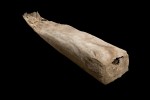 Now the team had to lift the lead coffin before they could remove the fractured sarcophagus. They did this by dismantling one end of the limestone box, taking it apart piece by piece according to the existing fracture pattern. When they made enough space for it, they slid a wooden board underneath the lead coffin and two people lifted the lead coffin out like they were carrying it on a stretcher. The coffin was then transported to an infirmary so the insides could be explored with an endoscope to make sure there were no preserved soft tissues requiring special conservation conditions. There weren’t any; the remains were fully skeletonized.
Now the team had to lift the lead coffin before they could remove the fractured sarcophagus. They did this by dismantling one end of the limestone box, taking it apart piece by piece according to the existing fracture pattern. When they made enough space for it, they slid a wooden board underneath the lead coffin and two people lifted the lead coffin out like they were carrying it on a stretcher. The coffin was then transported to an infirmary so the insides could be explored with an endoscope to make sure there were no preserved soft tissues requiring special conservation conditions. There weren’t any; the remains were fully skeletonized.
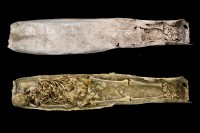 Armed with the endoscope data, the team’s next step was opening the lead coffin. There were still intact solder joints that researchers did not want to damage because they could contain information about the construction of the coffin, so instead they decided to cut an opening all around the base of the coffin, lift the lid and sides and leave the skeleton on the lead base. In addition to the skeletal remains, archaeologists found some hair, small fragments of a fragment that looks like linen and a piece of cord. The fabric is probably what’s left of the shroud the deceased was wrapped in while the cord is a piece of the rope used to secure the shroud by tying around the legs.
Armed with the endoscope data, the team’s next step was opening the lead coffin. There were still intact solder joints that researchers did not want to damage because they could contain information about the construction of the coffin, so instead they decided to cut an opening all around the base of the coffin, lift the lid and sides and leave the skeleton on the lead base. In addition to the skeletal remains, archaeologists found some hair, small fragments of a fragment that looks like linen and a piece of cord. The fabric is probably what’s left of the shroud the deceased was wrapped in while the cord is a piece of the rope used to secure the shroud by tying around the legs.
When the stone sarcophagus was first unearthed, experts thought it might have contained the remains of Sir William de Moton of Peckleton, a knight and former mayor of Leicester who was buried at Grey Friars in 1362. Its location in presbytery of the friary church near the high altar was extremely prestigious, and a stone coffin with a lead coffin inside was an ultra deluxe burial package, a combination only someone with a great deal of wealth and position would be able to secure. Sir William seemed the likeliest candidate at first glance. Documentary research discovered two other possible candidates: leaders of the English Franciscan order Peter Swynsfeld (d. 1272) and William of Nottingham (d. 1330).
Well, throw all of that out because surprise, the skeleton inside the lead coffin is female! She was a woman of means, as confirmed by stable isotope analysis of her bones which found that she ate a high-status, protein-rich diet — game, meat and a great deal of sea fish — only just below Richard III’s adult diet in quality. She was over 60 at time of death and radiocarbon dating found she died in the latter half of the 13th century or in the 14th.
Documentary research found the names of seven women closely associated with the friary. The radiocarbon dating results eliminated three names of women who died in the 16th century. Of the four remaining, the biggest shot was Eleanor, Countess of Leicester, who was a dedicated patron of the friary. She died in France, however, and as far as we know was buried there as well. Of the three remaining women on the list, only one is specifically recorded as having been buried in the church: Emma Holt. All we know is her name and that she was buried in the friary church in 1290 because in September of that year, the Bishop of Lincoln issued an indulgence shaving Purgatory sentences off by 20 days for anyone who would say “a Pater and a Ave for the soul of Emma, wife of John of Holt, whose body is buried in the Franciscan church in Leicester.” There’s no way to confirm is our leaden lady is Emma Holt. There are no known descendants for DNA matching. We don’t know her age at death, her looks or anything else about her that could link her to the skeleton.
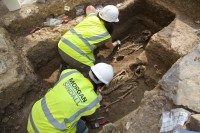 Although the identity of the woman who had such significance to the Franciscan order that she was buried in the fanciest casket in the fanciest part of the friary’s church is likely to remain unknown, it is worth noting that she was not the only woman granted the honor of being laid to rest under the feet of praying monks. In the two Grey Friars digs, archaeologists found 10 graves. Five were left undisturbed in place. Five were excavated and the remains examined. One of those five proved to be King Richard III. The other four were all women.
Although the identity of the woman who had such significance to the Franciscan order that she was buried in the fanciest casket in the fanciest part of the friary’s church is likely to remain unknown, it is worth noting that she was not the only woman granted the honor of being laid to rest under the feet of praying monks. In the two Grey Friars digs, archaeologists found 10 graves. Five were left undisturbed in place. Five were excavated and the remains examined. One of those five proved to be King Richard III. The other four were all women.
Two of them were inside the choir on the opposite side of it from where Richard was found. They were between 40 and 50 years old at time of death and radiocarbon dating shows indicates they died between 1270 and 1400. One of them had what seems to be a congenital hip dislocation which would have required her to walk with a crutch. The other lived a life of physical labor. Her arms and legs bore the tell-tale sign of regular use in lifting heavy weights. Like the woman in the lead coffin, these ladies also ate a high quality, varied diet rich in proteins.
The fourth female skeleton had been disturbed — note for RM: these were the disarticulated female remains mentioned in the first press conference — so there’s limited information on her, but she too appears to have done hard physical labor in her short life before dying in her early to mid-20s. Since the choir and presbytery would be reserved for important, wealthy people, the fact that two women who did hard labor for years were buried there may suggest the friary’s top donors were not just aristocrats and clerical leaders, but members of the burgeoning middle class of merchants and tradespeople who had money in their pockets but made it by working hard with their hands.
As for the ratio of men to women being so lopsided, as unexpected as that is, it could very well just be a coincidence.
Grey Friars site director Mathew Morris, who led the dig said: “Although it might seem unusual that Richard III is the only male skeleton found inside the Grey Friars church, the other four skeletons all being female, it must be remembered that we have only excavated five of ten identified graves in the church’s chancel with the potential for hundreds more burials elsewhere inside the church, the other friary buildings and outside in the cemetery.
“Excavations of other monastic cemeteries have found ratios ranging from 1:3 to 1:20 woman to men buried, with urban monastic cemeteries typically having greater numbers of women buried in them than rural sites.
“In Leicester, ULAS’s excavation of the medieval parish church of St Peter (today situated beneath the John Lewis store in Leicester’s Highcross retail quarter) found that the burial of men and women inside the church was broadly equal.”
Here’s a brief documentary video of the lead coffin’s removal from the stone sarcophagus in situ and its opening in the laboratory. You can see how they took apart the stone coffin, how they cut the lead with what look like pruning shears and the fragments and remains inside in the lead coffin.
[youtube=http://youtu.be/xXvvV9WQ_1c&w=430]